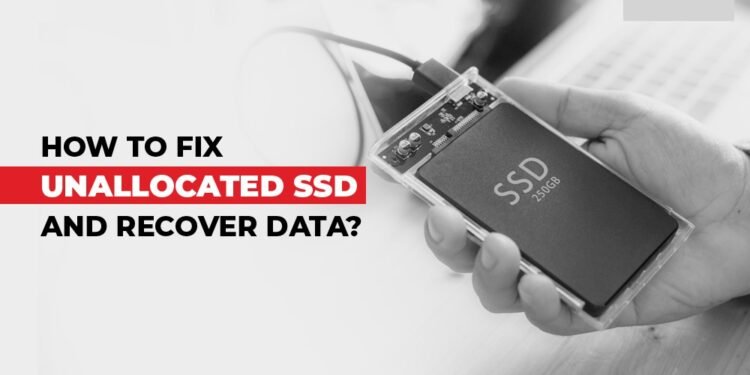In today’s digital era, Solid State Drives (SSDs) have become one of the most preferred storage devices, mainly known for their lightning-fast speed, durability, and performance. However, sometimes your SSD may get unallocated in Windows Disk Management, and all its stored content becomes inaccessible. Such issues make your Windows PC detect the drive, but its stored files and partitions remain inaccessible.
Fortunately, several effective methods are available to fix the unallocated SSD issue and recover your lost data safely. In this guide, we’ll explore different workarounds on how to fix an unallocated SSD and recover data in Windows. Let’s get started!
What Does “Unallocated SSD” Mean?
If your SSD appears unallocated on Windows Disk Management, it means the drive space isn’t assigned to any partition or file system. The unallocated area can’t store data until it’s properly partitioned and formatted.
In simple terms, when your SSD is unallocated, it will be recognised by your computer, but cannot access or display any files because it doesn’t know how the data is organised.
Common Reasons for Unallocated SSD on Windows
Before you use any method to fix unallocated SSDs, it’s important to understand the exact cause of the issue. Some main reasons include:
- Accidental Deletion of Partition: You might’ve accidentally deleted the volume or partition while managing disks in Disk Management or during OS installation.
- File System Corruption: Corrupted file systems can make Windows unable to read partition information, causing the SSD to appear unallocated.
- Bad Sectors or Drive Errors: With continuous usage for a long time, SSDs develop bad sectors or physical damage, which lead to loss or deletion of stored data or certain partitions.
- Virus or Malware Attacks: Malicious programs like viruses or malware can modify partition information or corrupt the MBR (Master Boot Record).
- Operating System or Driver Issues: Incompatible drivers or sudden power failures during disk operations can also cause an SSD to become unallocated.
Quick Steps to Confirm If Your SSD Is Unallocated
Follow the below steps on your Windows PC to check whether your SSD is unallocated:
- Press the Windows + X keys and select Disk Management.
- Check for your SSD in the bottom panel.
- If “Unallocated” appears, it means Windows cannot read the partition table.
How do I Fix an Unallocated SSD? [Quick Methods]
There are several methods, depending on the cause, that you can try to fix an unallocated SSD. Let’s go through them one by one.
Method 01: Assign a Drive Letter
Assigning a drive letter can help you fix the unallocated SSD. This process helps Windows recognise the SSD and make it accessible again. All you have to do is:
- Press the Windows + X keys and launch Disk Management.
- From the list of drivers that appear, select your SSD.
- Right-click on the SSD partition that you need to assign a drive letter.
- Choose “Change Drive Letter and Paths…”.

- Click Add and select a drive letter from the drop-down menu.

- Click OK to conclude the process.
Once the drive letter is assigned, check File Explorer to see if your SSD now appears and is accessible.
Method 02: Create New Partition Using Command Prompt (DiskPart)
Re-partitioning the SSD helps Windows recognise the drive properly, allowing you to create new volumes and restore full access to your storage space. Before you proceed with the steps to create a new partition on your unallocated SSD, create backups of your important data. Here’s how to use DiskPart to create a new volume:
- Type CMD in the search box of your desktop, right-click on Command Prompt and select Run as Administrator.
- Now, type the following command one by one:
- diskpart
- list disk
- select disk X (Replace X with the disk number of your SSD)
- create partition primary
- format fs=ntfs quick
- assign letter=X
- exit
After this, your SSD should appear in File Explorer.

Method 03: Update or Reinstall SSD Drivers
Sometimes, it’s outdated or faulty drivers on your Windows PC which prevent it from accessing the SSD. In such a case, you can follow the below steps to update SSD drivers:
- Launch Disk Manager, then expand Disk Drives.
- Right-click your SSD and choose Update driver.
- Select Search automatically for drivers.
- Restart your computer and check if the SSD appears normally.

If the issue keeps existing, uninstall the SSD driver and restart the system. Windows will reinstall it automatically.
Additional Tip: How to Recover Data from an Unallocated SSD?
Instances may happen when you encounter data loss on your SSD when it appears unallocated. In data loss cases, you can use previously created backups or professional data recovery software to recover your lost files. Stellar Data Recovery Professional is a powerful tool designed to recover lost or deleted data from unallocated, formatted, or corrupted SSDs. You can use this software to recover deleted files of various types, including documents, photos, videos, etc.
Here’s how to recover data in Windows using this professional data recovery software:
Step 1: Download the Stellar Data Recovery Professional software from its official website on your Windows PC. Install the software on a different drive to avoid overwriting data on the affected SSD.
Step 2: Launch the software and from the homepage, select the type of file you need to restore or choose “All Data”. Click Next to continue.

Step 3: From the “Recover From” screen, click “Can’t Find Drive” under the list of available drives. This option helps detect partitions that have become unallocated or lost.

Step 4: Now, choose your SSD from the list and click Scan to initiate the scanning process.
Step 5: Once the scan is complete, preview recoverable files and select the one you want to restore. Click Recover to save recovered files to a different storage location (not the same SSD).

Tips to Prevent SSD Corruption in the Future
Now that you are familiar with different methods to fix unallocated SSDs, it’s time to check some tips to avoid such unallocation again. This includes:
- Avoid unexpected or sudden system shutdowns or power failures while transferring data.
- Keep your SSD firmware, drivers and device OS up to date.
- Use a reliable antivirus tool to prevent issues like malware-based partition corruption.
- Create regular backups of your important files using external drives or cloud storage.
- Use the “Safely Remove Hardware” option before disconnecting any external SSD.
Conclusion
An unallocated SSD can put you in trouble, especially if it contains important files. However, when the aforementioned fixes you can easily fix the issue. Before you apply these workarounds, create a backup of your important files using cloud backups or an external hard drive. However, if you find any file missing from a Windows PC while fixing the unallocated SSD issue, use third-party professional data recovery software tools like Stellar Data Recovery Professional.
By following the steps above and maintaining proper storage practices, you can keep your SSD healthy, functional, and data-safe for years to come.


































